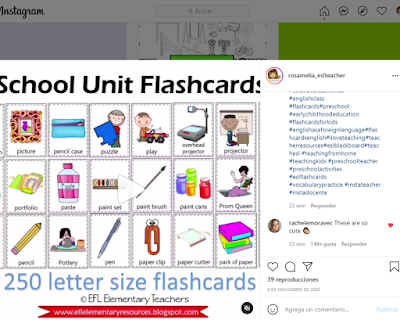It is available in my other store:
Watch the video of the complete resource:

Review the rooms in the house with the
flashcards.
Use
the House and the family flashcards
to make a grid that can look like a house on the board.
Teacher: Who is she?
Teacher: Where is she?
Student: She’s in the bathroom.
Teacher: Is uncle Tom in the bedroom?
Student: Yes, he is.
Teacher: Where is Brother?
Student: He’s in the dining room.
Teacher: Who is in the living room?
Student: The cousin is.
Say a place and the students say the family member and
then do the opposite.
Teacher: kitchen!
Student: Grandma!
Model
and have students make plural sentences.
Teacher: The cousins are in the bathroom.
Student: The brothers are in the bedroom.
Teacher: Who are in the dining room?
Student: The aunts!
Teacher: Where are the babies?
Student: They are in the living room.
I made this craft
house to use for speaking
purpose using prepositions.
It comes in two parts to make a bigger house
to display to the class.
Use
it to make sentences with prepositions.
Assemble one or several houses for the class.
Teacher: Put the brother in front of the house. Put
the uncle next to the house. Put the mother next to the house.

I
opened the windows and doors to review more prepositions.
Teacher: Where is the cousin?
Student: He is behind the window.
Teacher: Where is the cousin?
Student: She is in the house.
Students can make sentences: Brother is in front of the house. Mother is next to
the house. Grandpa is between Mother and Grandma.
Print the Rooms in a house to use with the family members.
I made a house out of file folder. It is easier to carry around and play.
Label the rooms in the house. (LABELING)
The
family members are in the house. Dictate where the members are.
Teacher: Aunt is in the bedroom. The cousin is in the
bathroom. Grandma is in the living room. Father is in the dining room. The baby
is in the kitchen.
Ask
questions:
Teacher: Where is the cousin?
Student: She’s in the bathroom.
Teacher: Who is in the living room?
Student: Grandma is.
I made small word cards to make sentences.
The video!
A worksheet
for many activities.
The house can be colored by room.
Teacher: Color the
bathroom blue. Or it can be colored by
objects in the house. Dictate where to place the family members in the house.
Do this as a listening activity.

The house can be colored by objects in the house.
It can be done as a writing activity on the
notebook.
Follow me at my Facebook group!! https://www.facebook.com/ESLPreschoolTeachers



























































